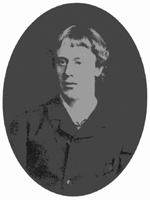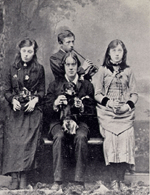


Estonia 1884 - 1887
For a man with a fortune at his fingertips Eric often claimed to be penniless in the 1880's. This may have been because his money was tied up in property or, as John Adlard suggests that his step-father controlled his finances. In 1884 his debts to London cerditors were so severe that he decamped to Belgium where he stayed for the whole winter at No 7 Marnixplaats in Antwerp. The proximity of this street to the theatre district can have done nothing to ease his financial situation.
In 1885 he wrote The Ballad of Creditors, a jaunty poem which is printed for the first time in the Durtro edition of his complete poems.
In February 1885 his Grandfather in Estonia died and Eric, as the oldest direct heir, inherited the extensive estates. It is clear that he was in close contact with the family in Estonia at this time as he was able to get to the house in Kolga by the end of March. His friend Frank Costelloe came with him for moral support and, one suspects, financial advice. But Costelloe had to return to England in May for his wedding to Mary Smith, daughter of the Wesleyan preacher Robert Pearsall Smith.
Without his anchor Eric became more eccentric adopting bright clothes, such as a bright green suit with an orange shirt, and smoking increasing amounts of opium. One wonders what his traditional peasent workers thought of him.
 A visitor at the
time describes him as having "...red-gold curls that swept
his shoulders (and), dreamy sky blue eyes..."
A visitor at the
time describes him as having "...red-gold curls that swept
his shoulders (and), dreamy sky blue eyes..."
As befitting his status he had a personal servant and lived in his own suite of rooms at the top of the house. Here too his eccentricity was obvious. One huge room was wallpapered poppy red and he kept a menagerie of animals including snakes and a monkey.
His huge bedroom was painted peacock blue and covered in the trappings of esoteric and occult beliefs. There was a pentagram over the bed and an altar over the fireplace dedicated to Eros. By now he had also evolved his own religion comprising a mix of Buddhism, Catholicism and Idolatry.
 But
it wasn't all drugs and indulgence. In Kolga he had an extended family
of cousins, aunts and uncles who were all very fond of him. In particular
his thirteen year old cousin, Karin (seen here on Eric's right) hero
worshipped him and talked about marrying him when she got older.
But
it wasn't all drugs and indulgence. In Kolga he had an extended family
of cousins, aunts and uncles who were all very fond of him. In particular
his thirteen year old cousin, Karin (seen here on Eric's right) hero
worshipped him and talked about marrying him when she got older.
Eric was very sensitive to family matters and felt that he, an unmarried man, should not be sole heir when his married cousins with families had little. He tried at first to give them money from the estate but they refused it. Then later he signed over much of the Kolga estates to them on the excuse of providing homes for their children.
Though I do not believe he was sexually interested in children, he may have very well been gay, Eric did prefer the company of young people to those of his own age. And, in spite of his constant ill health he composed poems, plays and short stories, some of which still survive in family records, for his many neices and nephews. He also formed a club, The Idiots Club, with Karin and her siblings to put on those plays.
Eirc stayed in Estonia for some time but was back in England in 1887. It seems that after his neices and nephews went back to school he was lonely and missed England. He never returned to Estonia.
![]()



